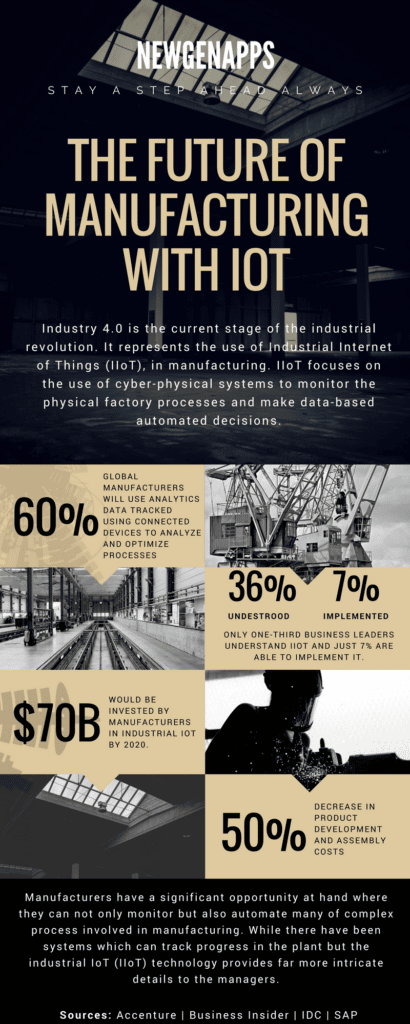BLOG
How Industrial IoT Applications Are Shaping Our Future
In case you missed it, we’re in the middle of what the World Economic Forum calls the Fourth Industrial Revolution–and what’s turning out to be the era of the internet of things.
Wonder how we got here? Here’s a recap:
- The First Industrial Revolution marked the initial shift to factories and mass production, powered largely by water and steam.
- The second used electric power for mass production.
- The third, the digital revolution, used electronics and information technology to automate production. This is where we began to move from mechanical and analog to digital, setting the stage for the fourth, where we are now.
The Fourth Industrial Revolution has ushered in the age of smart manufacturing (or intelligent manufacturing) which focuses on harnessing the power of digitization-hence, the industrial Internet of Things (IIoT).
Now, in terms of the industrial IoT, GE has certainly put a stake in the ground. It led Enterprise Management 360’s (EM360) list of top IIoT companies. GE also offers one of the best definitions of IIoT we’ve seen:
[IIoT], also known as the Industrial Internet, brings together brilliant machines, advanced analytics, and people at work. It’s the network of a multitude of devices connected by communications technologies that results in systems that can monitor, collect, exchange, analyze, and deliver valuable new insights like never before. These insights can then help drive smarter, faster business decisions for industrial companies.
GE, along with AT&T, Cisco, Intel, and IBM, is a founding member of the Industrial Internet of Things Consortium, whose motto is “things are coming together.”
Indeed, they are.
Forbes contributor Louis Columbus, principal at IQMS, reports that the global IoT market is predicted to grow from $2.99 trillion in 2014 to $8.9 trillion in 2020.
Industrial manufacturing is expected to increase from $472 billion to $890 billion over the same period-the largest portion of global IoT spending.
In honor of the fourth industrial revolution, we’ll take a brief look at four examples, starting with what may be one of the most fascinating IIoT applications, the digital twin.
Digital Twins in Manufacturing
Broadly speaking, “digital twin technology” refers to the digital representations–or counterparts–of physical objects. (The term isn’t completely universal yet; Hitachi, calls them asset avatars.)
Roughly half of large industrial companies will be using digital twins by 2021, Gartner predicts. Gartner is, to say the least, bullish on twins: Last year it included digital twins in its Top 10 Strategic Technology Trends for 2017.
Think of it as the nexus of big data meets big manufacturing. Digital twins make predictive maintenance easier, and provide visualization capabilities to improve efficiency. But successful deployment of digital twins demands continuous updating of data collection capabilities and curating, as well as adaptive analytics and algorithms, according to Gartner.
If we have to pick just one example of this, we’ll go with GE’s Predix platform. (According to EM360, Predix is the first IIoT platform and the largest in the world.)
Predix has enabled the creation of digital twins for everything from car engines to power turbines. In fact, according to Deborah Sherry, VP and Chief Commercial Officer at GE Digital, the company has nearly a million digital twins in place It provides a digital twin for every piece of equipment. For example, each jet engine has one. Each engine tracks 5,000 parameters from 24 sensors. This means a company can predict what happens to the engine and when it will need maintenance, according to an interview on the IOT Institute website.
And, adds Sherry, “If you determine what a repair should look like, you can simulate it with a digital twin to make sure it is going to work. And then you send the right technician, at the right time, with the right tools.”
Predictive maintenance may end up being best thing to come out of IIoT technology, and it’s not limited to digital twins. It makes it possible to pinpoint when equipment needs to be repaired or replaced, avoiding damage and/or downtime. That has tremendous implications for many industries, including agriculture.
Farming the Future
Predictive maintenance is making a significant difference in farming equipment. Take, for example, John Deere. Farming vehicles are digitally connected to the JDLink platform, providing access to location, utilization, and diagnostic data for each machine.
In addition, location data ensures tractors do not overlap when seeding or fertilizing. As an AIG case example points out, networked sensors and historical and real-time data on weather, soil conditions, and crop status help farmers make informed decisions, including those about planting and harvesting. John Deere calls this “agronomic optimization.”
John Deere is also deploying IIoT technology–perhaps most interestingly, with self-driving tractors, according to Internet of Things Institute.
This image is courtesy of www.newgenapps.com.
Improving the supply chain
IIoT can provide access to real-time supply chain information by tracking materials, equipment, and products as they move through the supply chain.
With embedded IoT sensors, equipment can communicate data about parameters such as the temperature and usage of the machine, according to Gartner. And it can adjust equipment settings and process workflow as needed, optimizing performance across the supply chain.
Here, we have to point–as we often do–to Maersk.
Shipping millions of containers to 120+ countries, Maersk uses the IIoT to keep track of its assets, manage fuel consumption, and optimize the routes of its ships, according to a Bloomberg News profile. This has been especially useful for refrigerated containers, which require strict temperature control.
And the next industrial IoT application from Maersk, according to the article? Autonomous, self-sailing ships. That could reduce error (most maritime errors are human errors), solve the problem of workforce shortages, save money the cost of housing and paying sailors, and convert crew space to cargo space.
Energy and Utilities
By 2020, the size of the IIoT in the utilities market is predicted to reach nearly $12 billion, according to a Research and Markets report.
On the relatively simple side, we have smart meters, Business Insider reports, that utility companies, including California’s PG&E, are starting to use. Smart meters track customers’ energy usage and communicate that to the utility company. This gives the company the data to help it predict demand, identify outages sooner and know when repairs are needed. .
Real-Time Innovations (RTI), along with its partners National Instruments, Cisco, and Wipro, has developed a smart-grid technology that divides the power grid into an array of microgrids that can each be managed independently. This application won the 2016 Industrial Internet Consortium Testbed Award.
Microgrids may operate independently, but they interact with existing grid infrastructure. Among the benefits: more efficient integration of solar and wind into the grid. “The traditional monolithic method of transmitting electric power is simply not up to the task of managing a grid that derives most of its power from renewable sources,” according to IIoT Institute.
And of course, it allows for predictive maintenance and safety oversight.
And Desktop Fish Tanks?
By embracing IIoT, companies are streamlining processes, reducing downtime, and using data to make smarter–and faster–business decisions. And it’s only going to expand. From warehousing, to automotive manufacturing, from worker safety, to protecting the environment, the IIoT is poised to change everything.
Reach out to our team today, and learn how Very can help your team gain new insights through IIoT.










